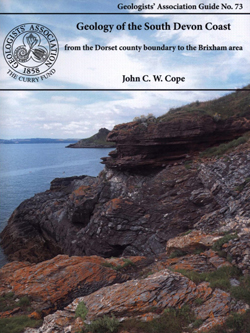
This field guide to the South Devon coast carries a sub-title because there is a constant debate, even in Devon, over what constitutes South Devon or South-East Devon. In essence, it continues the story of the Dorset Coast westwards within the districts of East Devon, Teignbridge and Torbay.
Like all Geologists’ Association Field Guides of modern times, this guide is both colourful and informative, with a wealth of small maps and photographs coupled with access and parking information. The East Devon part of the guide clearly includes the UNESCO Dorset and East Devon World Heritage Site (the ‘Jurassic Coast’) and while this is a mouthful, abbreviating it to Heritage Coast can be confusing. Equally, the English Riviera UNESCO Global Geopark, is another mouthful, although it is scarcely mentioned.
The introductory pages include a digest of all the terminology connected to the stratigraphy and for some this can appear to be a daunting read. The importance of Devon in the establishment of the Devonian System is mentioned, though the early work on the counties of South-West England by Sir Henry De La Beche (1839) is not mentioned. The early work on the Torbay area (and elsewhere in South-West England) by William Pengelly and other founder members of the Devonshire Association is deserving of greater mention because they tackled such issues as cave exploration, the formation of the Dartmoor Granite, sea-level changes (including raised beaches, submerged forests, etc.) and the origin of the ‘Red Beds’ in the Torbay area.
The guide is genuinely comprehensive in coverage and one must avoid the temptation to pick on what is missing rather than what is covered. That said, there are three areas that could have been used more fully in explaining the geology of the area covered by the guide. The first of these is Ladram Bay where there is a description of the succession and the presence of rhizoconcretions (calcareous concretions developed around plant roots). There is, however, no mention of the famous occurrence of rhynchosaurs in these strata, especially around Ladram Bay. Clearly not every visitor will find bones of these vertebrates, but being aware that they can be present might mean that they are spotted by those looking at these river channel sandstones. There are very good ‘dioramas’ available that could have been used (with suitable permissions) to illustrate the palaeoecology of the succession.
The other also concerns the ‘Red Beds’ along by the railway line between Dawlish Station and Langstone Rock. While the channels filled with breccias are mentioned, one can obtain really good images of floods of coarse sediment apparently stopping in mid-flow, presumably having run out of energy within the dune sands or perhaps even water.
In many parts of the succession there has been microfossil and palynological research that has contributed to our understanding of the stratigraphy or the palaeoenvironments. Very little of this is mentioned and while it is fully appreciated that such fossils are not seen in the field, the interpretations are still important in the overall understanding of the area covered by the guide.
In summary, this is another valuable contribution to the Geologists’ Association range of field guides and I am sure that it will become popular amongst visitors to the area, many of whom come as part of organized groups.
Reviewed by Malcolm B. Hart
GEOLOGY OF THE SOUTH DEVON COAST: FROM THE DORSET COUNTY BOUNDARY TO THE BRIXHAM AREA, by Cope, J.C.W., 2017. Geologists’ Association Guide No. 73, 122pp. (pbk.)
List price: £ 12.00
Fellow's price: £ 9.00
W: https://www.geolsoc.org.uk/GA073